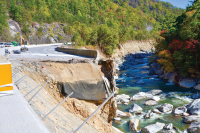Whose woods are these? N.C. governor battles Bush administration over road-building in national forests
North Carolina Gov. Mike Easley called last week for roadless areas to be protected in the Nantahala and Pisgah national forests — in opposition to a Bush Administration move last year that lifted bans on logging and road building in roadless areas.
“These forest areas are vital not only for their natural beauty and the recreational opportunities they offer but also for their environmental benefits, including providing clean water and wildlife habitat,” Easley said in a press release. “They are unique places of unspoiled wilderness and beauty and must be protected and preserved.”
The urgency to protect these natural areas has come into even sharper focus with the recent proposal by the Bush Administration to sell off pieces of the national forest, according to Easley’s press release. Easley has also come out against the national forest sell-off, which would include about 6,500 acres of in the Pisgah and Nantahala.
Protections for the national forest’s last roadless areas were put in place in 2001 following an extensive, three-year public process initiated by the Clinton Administration. More than 600 public hearings were held across the country generating 1.4 million comments — 96 percent of which called for roadless areas to be placed in a locked box.
By comparison, the Bush Administration’s proposal to reverse the protections underwent only a 120-day written comment period. Bush’s new policy asked governors to weigh in on the fate of roadless areas in their state. Carte blanche protections for roadless areas imposed a one-size-fits-all approach, according to the Bush Administration. Governors were better equipped to develop preferred management policies for roadless areas in national forests, it was decided.
Environmental groups quickly went to work lobbying Easley to call for strong protections. Easley, too, moved quickly. Governors were asked to respond within 18 months — Easley only took nine. His recommendation is among the first to be turned in, and Virginia’s governor has already called for protections of the national forest roadless areas in his state as well.
Easley criticized the U.S. Forest Service’s decision to reverse roadless area protections and placing the onus on states to propose national forest management policies.
“This new process places a burden on states to protect lands that are a federal responsibility and presents states with an onerous petition process that is, frankly, unclear,” Easley said in a press release. “But North Carolina will move ahead to protect these lands for the sake of the state’s environment and its people.”
There is no obligation by the forest service to follow recommendations made by governors, however. The forest service has six months to begin a public review process that will hone the official policy for roadless areas in the state and include public input.
Easley is concerned about the vulnerability of the roadless areas in the meantime and asked for a moratorium on logging and road building in these roadless areas of the national forests until the official policy is adopted.
“In light of the bureaucratic and burdensome process, Easley is asking that the (forest service) expedite consideration of the petition and provide for temporary protection of the land while federal officials deliberate,” the governor’s press release stated.
The national forests in the Southern Appalachians contain 9,500 miles of roads. Most forest roads are built to reach areas slated for logging — to get equipment and trucks in and haul the logs out — after which many are left to erode and deteriorate. The Forest Service claims a $10 billion national backlog on maintence of existing roads.
The national forests in the Southern Appalachians have a smaller percentage of roadless areas than other regions. The mountains here were heavily logged and farmed 100 years ago, making roadless areas relatively small and scarce.
A recent Forest Service study shows that by 2050, demand for backcountry recreation in the national forests will increase 150 percent from 1990 levels. According to the Southern Environmental Law Center, outdoor recreation contributes 28 times more to the economy than logging.





